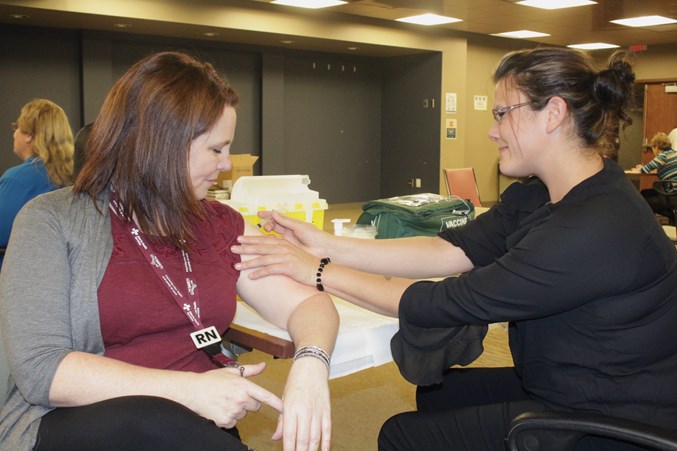Alberta Health Services (AHS) annual influenza immunization campaign begins Oct. 15, with a host of free clinics slated in and around Westlock.
The first clinic goes Oct. 15 at the Westlock Administrative Building at 9732 100 Ave. from 9 a.m. to 3 p.m. and then again on Oct. 24 from 1 p.m. to 8 p.m.
Busby School will be the site of the Oct. 18 clinic, which runs from 4 p.m. to 6:30 p.m.
Westlock Community Health Services, located at 10024 107 Ave., will host clinics Nov. 1, 8, 15, 22 and 29. Those will run from 9 a.m. until noon and then in the afternoon from 1 to 3 p.m.
Meanwhile, Pembina North Community School will host a clinic Nov. 6 from 4 to 6:30 p.m.
More dates and times for area clinics can be found at: https://www.albertahealthservices.ca/influenza/influenza.aspx. In addition, local pharmacies are offering the shot — see their ads in this week’s print edition of the Westlock News.
The shot is available all Albertans over six months of age, for free, though there may be restrictions depending on where you get it.
While pharmacists are able to administer the vaccine, they can only provide it to children over the age of five. In fact, that age limit was lowered this season, as it was previously nine years.
“That age … of who can get the vaccine at the pharmacy has just dropped,” said Dr. Kathryn Koliaska, medical officer of health for the North Zone of AHS.
If your child is over six months of age, however, they can get immunized at any free community health clinic. Pregnant women can also receive the vaccine.
Influenza is a respiratory infection of the nose, throat and lungs that is caused by a virus. It differs from the stomach flu, which cannot be prevented by immunization and generally involves far less severe symptoms than influenza.
The virus is spread through the air when someone coughs, sneezes or even talks. It can also be spread by touching objects which someone has coughed or sneezed on.
Last year, there were 5,667 lab-confirmed cases of influenza ‘A’ and 3,402 lab-confirmed cases of influenza ‘B’ throughout the province, resulting in 3,047 hospitalizations and 92 deaths.
In the North Zone of AHS, there were 818 cases of influenza ‘A’ and 495 cases of influenza ‘B’, resulting in 10 deaths.
This year the province has ordered a total of 1.6 million doses of vaccine at a cost of $12.6 million, which would immunize approximately 35 per cent of the population.
Koliaska said that percentage isn’t high enough to achieve “herd immunity,” wherein so many people are immune to a disease that it effectively cannot spread.
“But even if we could decrease the amount of flu circulating by just getting more people immunized, that’s a good thing,” she added.
The vaccine this year protects against four different strains of influenza that experts from the World Health Organization predict will circulate this year.
In 2017-2018, a total of 1.229 million doses of vaccine were administered throughout Alberta, an immunization rate of 29 per cent. That includes 92,449 doses administered in the North Zone.
• With files from Kevin Berger.



